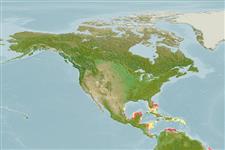>
Perciformes/Serranoidei (Groupers) >
Serranidae (Sea basses: groupers and fairy basslets)
Etymology: Hypoplectrus: Greek, hypo = under + Greek, plektron = sting, spur (Ref. 45335); floridae: Named for for the state of origin in the USA., Flirida.
Environment: milieu / climate zone / depth range / distribution range
Écologie
marin récifal; profondeur 1 - 10 m. Tropical
Western Atlantic: eastern Gulf of Mexico and South Florida.
Taille / Poids / Âge
Maturity: Lm ? range ? - ? cm
Max length : 10.0 cm SL mâle / non sexé; (Ref. 91468)
Description synthétique
Clés d'identification | Morphologie | Morphométrie
Épines dorsales (Total) : 10; Rayons mous dorsaux (Total) : 14; Épines anales: 3; Rayons mous anaux: 7. This species has the usual color and patterns of the brown Barred Hamlet but with several is distinguishing features: a pair of dark rounded spots at the base of the caudal fin found above and below the midline, usually symmetrical, present on all stages, including large adults; a break in the narrow mid-body bar (the fourth bar, after the wide mid-body bar) just above the lateral line, usually associated with well-delineated and unbroken bars to each side; usually a short rearward spur at the top of the last body bar (the fifth bar, forward of the caudal-peduncle bar), usually outlining a light wedge just below the base of the last dorsal-fin rays; some characters not usual on Caribbean Barred Hamlets, but typically associated with this species and H. ecosur include the bar under the eye being orange, even when the body bars are brown, and a dusky pelvic fin (Ref. 91468).
Life cycle and mating behavior
Maturité | Reproduction | Frai | Œufs | Fécondité | Larves
Victor, B.C., 2012. Hypoplectrus floridae n. sp. and Hypoplectrus ecosur n. sp., two new Barred Hamlets from the Gulf of Mexico (Pisces: Serranidae): more than 3% different in COI mtDNA sequence from the Caribbean Hypoplectrus species flock. J. Ocean Sci. Found. 5:1-19. (Ref. 91468)
Statut dans la liste rouge de l'IUCN (Ref. 130435: Version 2024-1)
Menace pour l'homme
Harmless
Utilisations par l'homme
Pêcheries: commercial
Outils
Articles particuliers
Télécharger en XML
Sources Internet
Estimates based on models
Phylogenetic diversity index (Ref.
82804): PD
50 = 0.5000 [Uniqueness, from 0.5 = low to 2.0 = high].
Bayesian length-weight: a=0.01778 (0.00683 - 0.04629), b=3.03 (2.80 - 3.26), in cm total length, based on LWR estimates for this (Sub)family-body shape (Ref.
93245).
Niveau trophique (Ref.
69278): 3.7 ±0.4 se; based on size and trophs of closest relatives
Fishing Vulnerability (Ref.
59153): Low vulnerability (10 of 100).
